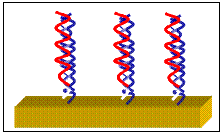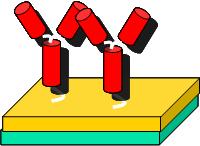
SEAM News
Calendar
Picture Galleries
|
Organic Electronics Laboratory The fundamental properties of electrically conducting polymers pave the way for modern applications. We maintain our interest in the solution and solid properties for these electroactive macromolecules. Our experience in molecular weight determination, fractionation, viscosity, dynamic light scattering and other solution properties build the basis for precision for assembly process and controlled phase separation. Surface area. Maximal surface area has its importance for catalysis and also redox based sensing. Our projects include porosity creation from blends, nanofibers from electrospinning, electrochemical growth from monolayers and chemical template polymerization. Precision. Hierarchical self-assembly optimizes systematic construction of complex functionalities. Precision for charge transfer is maximized with supramolecular electronics. Macromolecular entanglements can deteriorate the desired electrical properties and supramolecular self-assembly is a convenient the bottom build-up system. The indications for such have been achieved from the self-assembly studies of pi-conjugated molecules into cylindrical aggregates. The confined space for energy or electron traps has made the study of electron-transfer processes possible in the one-dimensional assemblies. Photon harvesting from sun has the great potentiality for generating renewable energy. The important factors: photon absorption, exciton migration, charge separation all the factors affecting the transport of recombination of photogenerated charge carriers need to optimized, at least systematically investigated: we create bicontinuous dual-phase materials following a systematic control of phase separation through critical conditions using poly(alkylthiophenes) with functionalized C60 molecules. Organic Electronics for Health Care Electrically conducting macromolecules provide the opportunity to build cheap, flexible and stable disposable electronics such as thin film electrodes, light emitting displays and field effect transistors. The devices can be ink jet printed, or printed with gravure, flexo or offset printing techniques. We have avoided the use of metal oxides as electrode substrates and developed a nanothick layer of an electrode on Nylon surface. Because the electrodes are organic, ionic polymers, they can be usedfor sensing ionic interactions. The changes in the ionization potential during binding of selective ligands with the targets can be identified using the developed sensors. Our technology has three focus areas:
|
 Surface imprinting as an antibody mimic for detection of target molecules of less than 30nm of size. The validation has been done with chiral amino acids, nerve gas degradation products, biomarkers such as dipicolinic acid and pesticides. The present funding is for the detection of FMDV and of proPSA.
Surface imprinting as an antibody mimic for detection of target molecules of less than 30nm of size. The validation has been done with chiral amino acids, nerve gas degradation products, biomarkers such as dipicolinic acid and pesticides. The present funding is for the detection of FMDV and of proPSA. Genetic Identification with our method can follow kinetically the differences during mutation [SNP] detection without any labeling applied. The single strand oligonucleotide probe is bound to the surface with ionic interactions but the hybridization with complementary strand can be detected with the our electrode as the double helix formation is energetically more favorable process.
Genetic Identification with our method can follow kinetically the differences during mutation [SNP] detection without any labeling applied. The single strand oligonucleotide probe is bound to the surface with ionic interactions but the hybridization with complementary strand can be detected with the our electrode as the double helix formation is energetically more favorable process.  Protein – protein interactions can also be monitored with electrodes prepared of organic electronic materials. Our results on antibody-antigen (Ab-Ag) show that the potential change during antigen binding is comparable to the potential changes observed with DNA hybridization. In addition to such remarkable sensitivity, the selectivity is ensured with antibody binding characteristics with the treatment of the exposed surface against non-specific binding.
Protein – protein interactions can also be monitored with electrodes prepared of organic electronic materials. Our results on antibody-antigen (Ab-Ag) show that the potential change during antigen binding is comparable to the potential changes observed with DNA hybridization. In addition to such remarkable sensitivity, the selectivity is ensured with antibody binding characteristics with the treatment of the exposed surface against non-specific binding.